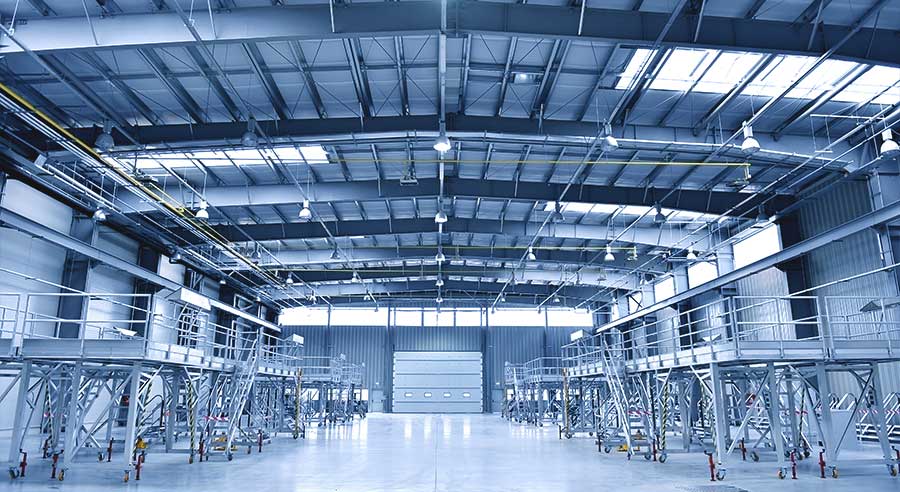HALL HEATING: 6 HEATING SYSTEMS AT A GLANCE
Warm air, panel heating or rather infrared? A wide variety of heating systems are available for heating halls. Depending on the requirements, one is more suitable, the other less. This article will give you an initial overview of the six most relevant systems for industrial and commercial halls and how they work.
Getting started - the difference between centralized and decentralized systems
Systems for heating halls are divided into centralized and decentralized systems. Centralized systems require a separate boiler room where heat is generated. This heat is then conducted to the heating devices, where it heats the heating medium conducted in it, which in turn provides heat for heating. This process is also known as "indirect heating." However, part of the heat is already lost through the transport. Decentralized systems, on the other hand, use the primary energy directly in the usable space or the heating unit itself, which first generates the heat where the employees need it. They do not require a separate boiler room, are more flexible and can be used more quickly.
Warm air heating of halls: You have these options
The basic principle behind warm air heating systems is very simple and quickly explained: a fan directs warm air into a room and heats it in this way. If you want to rely on warm air to heat halls, you have two options:
DECENTRALIZED HEAT SUPPLY VIA WARM AIR GENERATORS
In the case of direct-fired warm air generators, the burner generates the heat directly in a decentralized manner. By means of a heat exchanger, air drawn in on the secondary side is then heated and blown into the hall.
When heating halls with the help of warm air generators, room air-dependent and room air-independent modes of operation can be used. This means that the unit either draws in fresh air or heats the air from the hall itself. The latter is particularly practical. After all, since warm air is known to rise, the air in the working or floor area tends to be colder. Room-air-dependent warm-air heaters feed precisely this cool air back into the warm-air generator, thus providing a supply. Room-air-independent units, on the other hand, often additionally use the heat of the exhaust duct to heat the air supplied from outside.
CENTRAL HEATING OF HALLS WITH AN AIR HEATER
Indirectly heated air heaters, also called air heaters, do not heat the air themselves. Rather, a separate boiler or central heating system is connected here, which heats the heat exchanger externally. The air heater also draws in air and then passes it over the heat exchanger, which heats it. Then the warm air can be blown into the hall or distributed through air ducts. If you want to use an air heater to heat halls, you should again consider convection and plan accordingly for warm air recirculation or ceiling fans.
Surface heating systems for heating halls
Basically, you can install panel heating in the floor, ceiling or walls. Underfloor heating is probably the most common, but the system behind it is basically the same. For underfloor heating, thin pipes are laid in the floor in a snake-like pattern covering the entire area when the hall is built. Underfloor heating can also be installed later in an additional screed layer.
To heat halls, an externally heated heating medium (e.g. water) is passed through these pipes. The heat generated in this way can be felt directly in the floor and is only slowly released into the room, but remains there for a while even if the heating is switched off for a short time.
Please note with this heating system that too deep anchoring of shelves or machines can damage the heating hoses.
Not to forget: The radiant heating systems
When heating halls via radiant heat, a distinction is made between light and dark radiators. In addition, there are the ceiling radiant panels.
RADIANT CEILING PANELS
Also known as "hot water ceiling radiant panel," this system uses pipes welded to a metal plate directly under the ceiling. Similar to underfloor heating, hot water heated by an external heat generator flows through these tubes, transferring heat to the entire structure. A radiant panel then conducts the heat down into the room, where it raises the surface temperatures of all surfaces.
You should place an insulation layer between the ceiling and the radiant ceiling panel to reduce heat loss upward. If you want to use radiant ceiling panels to heat halls, you should also plan for a large heating area of about 15-20% of the ceiling area.
DARK RADIATORS FOR EFFICIENT HEATING OF HALLS
Dark radiators, also known as black radiators, are a variant of infrared radiant heating systems. In this case, halls are heated decentrally by individual units that use a burner to produce a long flame in a radiant tube. The energy source is usually natural or liquid gas, but biogas and hydrogen also have potential for the future.
Reflectors on the radiant tube direct the heat generated in the form of infrared radiation into the areas to be heated. There, this only provides heat when it hits the enclosure and surfaces of objects or people - similar to the sun. The decisive advantage of radiant heating of this type is therefore that no warm air physically rises under the ceiling and must be returned.
LIGHT RADIATORS: HEAT GENERATION VIA CERAMICS
Light radiators work in a similar way to dark radiators. A gas-air mixture is burned on ceramic plates, generating heat and emitting infrared radiation. Here, too, reflectors direct the rays specifically into the working area. The fundamental difference, however, is in the combustion process. In the case of bright radiators, combustion takes place openly - and thus the exhaust gases initially remain in the room. Indirect discharge of the exhaust gases is therefore necessary. Anyone who relies on bright radiator systems to heat halls must therefore ensure adequate ventilation.
What is particularly worthwhile for heating halls?
Which heating system is the right choice for you depends entirely on your usage profile and your economic requirements. For room heights of 4 meters and more, however, infrared dark radiators are recommended at this point, as they are particularly well designed for the physical characteristics of halls and are characterized by comparatively low investment costs with high efficiency, flexibility and operational reliability. Let us talk about it in a personal meeting - or use our configurator to find out which heating system is best suited for your object!




